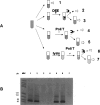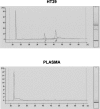Extracellular plasma RNA from colon cancer patients is confined in a vesicle-like structure and is mRNA-enriched
- PMID: 18456845
- PMCID: PMC2441977
- DOI: 10.1261/rna.755908
Extracellular plasma RNA from colon cancer patients is confined in a vesicle-like structure and is mRNA-enriched
Abstract
Little is yet known about the origin and protective mechanism of free nucleic acids in plasma. We investigated the possibility of these free nucleic acids being particle associated. Plasma samples from colon cancer patients and cell culture media were subjected to various antibody incubations, ultracentrifugation, and RNA extraction protocols for total RNA, epithelial RNA, and mRNA. Flow cytometry using a Ber-EP4 antibody and confocal laser microscopy after staining with propidium iodide were also performed. mRNA levels of the LISCH7 and SDHA genes were determined in cells and in culture media. Ber-EP4 antibody and polystyrene beads coated with oligo dT sequences were employed. We observed that, after incubation, total RNA and mRNA were always detected after membrane digestion, and that epithelial RNA was detected before this procedure. In ultracentrifugation, mRNA was caught in the supernatant only if a former lysis mediated or in the pellet if there was no previous digestion. Flow cytometry determinations showed that antibody-coated microbeads keep acellular structures bearing epithelial antigens apart. Confocal laser microscopy made 1- to 2-microm-diameter particles perceptible in the vicinity of magnetic polystyrene beads. Relevant differences were observed between mRNA of cells and culture media, as there was a considerable difference in LISCH7 mRNA levels between HT29 and IMR90 cell co-cultures and their culture media. Our results support the view that extracellular RNA found in plasma from cancer patients circulates in association with or is protected in a multiparticle complex, and that an active release mechanism by tumor cells may be a possible origin.
Figures






Similar articles
-
Epidermal growth factor receptor mRNA in peripheral blood of patients with pancreatic, lung, and colon carcinomas detected by RT-PCR.Int J Oncol. 2003 Feb;22(2):425-30. Int J Oncol. 2003. PMID: 12527944
-
Prognostic value of LISCH7 mRNA in plasma and tumor of colon cancer patients.Clin Cancer Res. 2007 Nov 1;13(21):6351-8. doi: 10.1158/1078-0432.CCR-07-0882. Clin Cancer Res. 2007. PMID: 17975147
-
Microarray-based identification and RT-PCR test screening for epithelial-specific mRNAs in peripheral blood of patients with colon cancer.BMC Cancer. 2006 Oct 20;6:250. doi: 10.1186/1471-2407-6-250. BMC Cancer. 2006. PMID: 17054783 Free PMC article.
-
New markers for cancer detection.Curr Oncol Rep. 2002 Nov;4(6):471-7. doi: 10.1007/s11912-002-0058-3. Curr Oncol Rep. 2002. PMID: 12354358 Review.
-
Liquid biopsy in patients with pancreatic cancer: Circulating tumor cells and cell-free nucleic acids.World J Gastroenterol. 2016 Jul 7;22(25):5627-41. doi: 10.3748/wjg.v22.i25.5627. World J Gastroenterol. 2016. PMID: 27433079 Free PMC article. Review.
Cited by
-
EPAS1 mRNA in plasma from colorectal cancer patients is associated with poor outcome in advanced stages.Oncol Lett. 2011 Jul;2(4):719-724. doi: 10.3892/ol.2011.294. Epub 2011 Apr 28. Oncol Lett. 2011. PMID: 22848255 Free PMC article.
-
Quantitation of cell-free DNA and RNA in plasma during tumor progression in rats.Mol Cancer. 2013 Feb 4;12:8. doi: 10.1186/1476-4598-12-8. Mol Cancer. 2013. PMID: 23374730 Free PMC article.
-
Human saliva, plasma and breast milk exosomes contain RNA: uptake by macrophages.J Transl Med. 2011 Jan 14;9:9. doi: 10.1186/1479-5876-9-9. J Transl Med. 2011. PMID: 21235781 Free PMC article.
-
Quantitative nanostructural and single-molecule force spectroscopy biomolecular analysis of human-saliva-derived exosomes.Langmuir. 2011 Dec 6;27(23):14394-400. doi: 10.1021/la2038763. Epub 2011 Nov 9. Langmuir. 2011. PMID: 22017459 Free PMC article.
-
High-Mobility Group A (HMGA) Proteins and Breast Cancer.Breast Care (Basel). 2010;5(2):81-85. doi: 10.1159/000297717. Epub 2010 Apr 9. Breast Care (Basel). 2010. PMID: 20847819 Free PMC article.
References
-
- Anker P., Stroun M., Maurice P.A. Spontaneous release of DNA by human blood lymphoctyes as shown in an in vitro system. Cancer Res. 1975;35:2375–2382. - PubMed
-
- Anker P., Lefort F., Vasioukhin V., Lyautey J., Lederrey C., Chen X.Q., Stroun M., Mulcahy H.E., Farthing M.J. K-ras mutations are found in DNA extracted from the plasma of patients with colorectal cancer. Gastroenterology. 1997;112:1114–1120. - PubMed
-
- Anker P., Mulcahy H., Chen X.Q., Stroun M. Detection of circulating tumour DNA in the blood (plasma/serum) of cancer patients. Cancer Metastasis Rev. 1999;18:65–73. - PubMed
-
- Bhowmick N.A., Chytil A., Plieth D., Gorska A.E., Dumont N., Shappell S., Washington M.K., Neilson E.G., Moses H.L. TGF-β signaling in fibroblasts modulates the oncogenic potential of adjacent epithelia. Science. 2004a;303:848–851. - PubMed
Publication types
MeSH terms
Substances
LinkOut - more resources
Full Text Sources
Other Literature Sources
Miscellaneous
